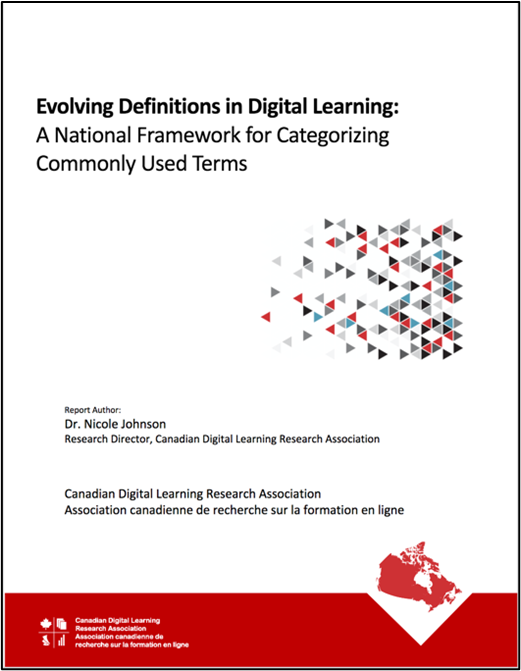A Courageous and Very Useful Stab at a Lexicon
by the Canadian Digital Learning Research Association

As preparations begin in earnest for a return to campus this fall, more colleges, polytechnics and universities are developing online and blended courses as a way to grow enrolment and meet the need for skills and capability development in a fast-changing employment market. They also see online and blended learning as a response to student and faculty concerns about COVID-19 and safety.
But what do the terms “blended” and “online” mean? And where does “hybrid” learning fit into the emerging lexicon? There are no common definitions across Canada’s post-secondary system, which makes it difficult for learners to understand their choices and for policy-makers to compare developments in different jurisdictions.
The situation is confusing, with varying definitions of what kind of learning is on offer within institutions as well as between them, even in the same geographical area.
In its listing of available online opportunities for learners in Ontario at studyonline.ca,
Contact North | Contact Nord is also challenged to make sense of these different definitions. Providing access to more than 42,800 courses and 2,718 online qualifications from Ontario’s 24 public colleges, 23 public universities and 9 Indigenous institutes, Contact North | Contact Nord adopted the language of “online anytime” (asynchronous), “online live” (synchronous), “blended” and “correspondence” to define modes of delivery.
The Canadian Digital Learning Research Association (CDLRA) has developed a definitional framework called the Modes of Learning Spectrum that it hopes will be a national language for policy-makers, institutions and students: Evolving Definitions in Digital Learning: A National Framework for Categorizing Commonly Used Terms.
The author of this lexicon, Dr. Nicole Johnson (Research Director CDLRA), is confident the definitions proposed will hold their meaning over time and be of value in creating a common, national understanding of types of learning delivery.

Dr. Nicole Johnson
Research Director
Canadian Digital Learning Research Association
The spectrum has two anchor points: (a) distance (remote) learning; and (b) in-person learning (face-to-face, on-campus learning).
Distance learning is defined as all learning that takes place at a distance.
Online learning (where the learning experience is delivered via the Internet either synchronously or asynchronously) is the predominant mode of distance learning.
However, distance learning also includes offline distance learning, in which the experience is fully remote but does not use Internet technology, such as a course that is delivered in print format through the mail.
In the early days of the pandemic, emergency remote teaching (video sessions with some use of learning management systems) was differentiated from intentional online learning, but both fall into the category of online learning for the purposes of this framework. Emergency remote teaching and intentional online learning should be considered two different types of online learning.
In-person learning is defined as learning that takes place entirely within a physical classroom with one’s peers and instructor physically present. In-person learning may use technology within the classroom, or technology available on-campus, to facilitate learning. Students may be expected to use technology (e.g., Learning Management System (LMS), digital textbooks, laptop computer) to complete course assignments.
The dividing line between distance learning and in-person learning is placed at the centre of hybrid learning. Hybrid learning is an experience that is designed to combine both online and in-person instruction. Although some institutions have separate definitions for hybrid and blended learning, it appears that these terms are used interchangeably for the most part. For consistency’s sake, the modes of learning spectrum uses the term hybrid learning, but considers it to be synonymous with blended learning.
Hybrid learning presents the greatest area of ambiguity, especially as different forms of it have emerged. Hybrid learning is an umbrella term that captures several things: “flipped learning,” (where class time is spent on group activities and peer learning and online learning is where content is explored), “hyflex learning” (where students can be either in class or online and learn together) and online learning with an in-person intensive component. There are varying definitions for these terms and further definitional work specific to types of hybrid learning appears to be needed.
As more and more micro-credentials appear on the scene - there are more than 512 programs and 3,430 courses in Ontario alone - with a marketplace that is national, not local — the way in which we describe their delivery matters. Making a choice to study a blended short course, for example, only to find that “blended” includes intense in-person, face-to-face learning rather than what the learner might have assumed it meant, could be seriously frustrating. The sooner institutions share a common language for how learning is delivered, the better.
This commentary quotes extensively from Evolving Definitions in Digital Learning: A National Framework for Categorizing Commonly Used Terms by Dr. Nicole Johnson.



